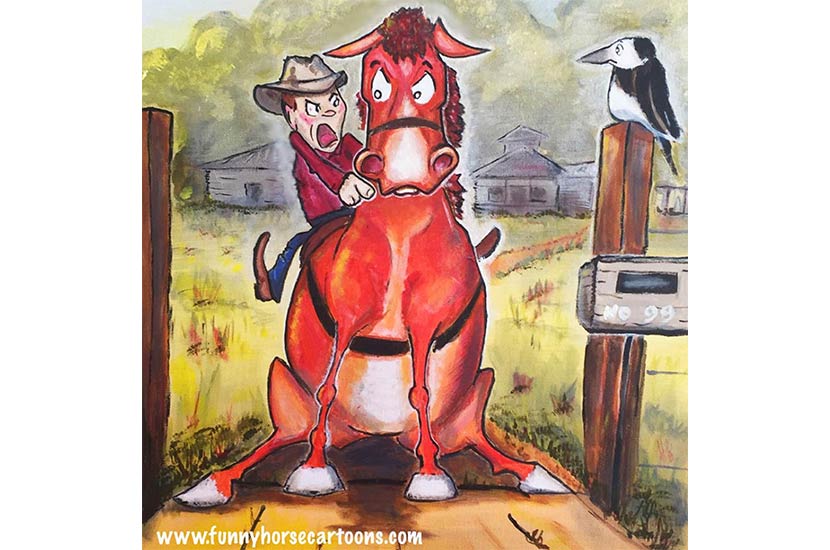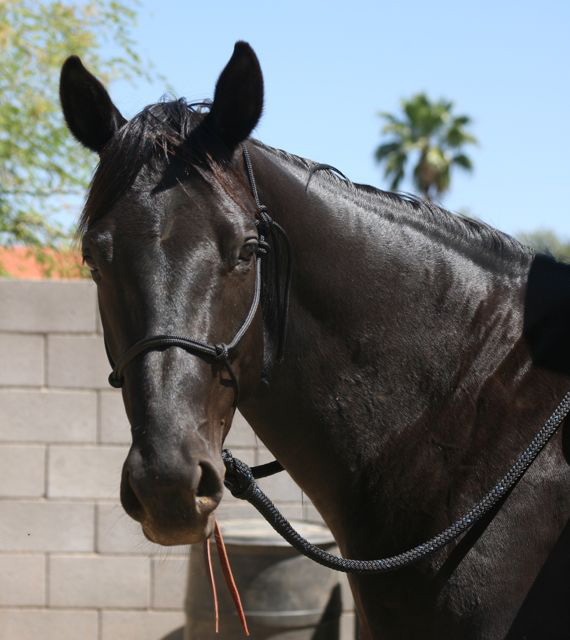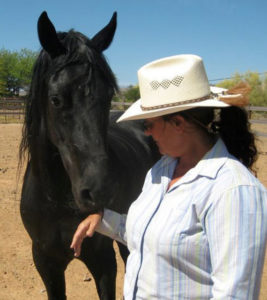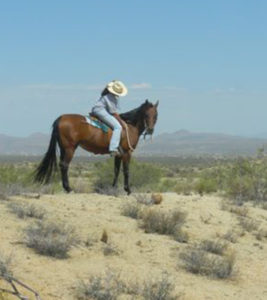What was surprising to me was that the #1 amount of replies said their horse was stubborn. Bucking came in second. Although I’m sure that bucking, as performed by the horse, in many of the replies also falls under stubborn as it’s your horse doing something you don’t want – really! Duh – and he’s still insisting on doing it. I have a really long list that I will tackle in order.
I’ve compiled and condensed 11 of the responses to my question on fb about people’s #1 challenge with their horses.
Here are the pertinent parts of what they wrote pursuant to our conversation about a “stubborn” horse. And based on the amount of replies that included issues that relate to “stubborn” I’m sure that many of you who didn’t write will find yourself reading about yourself through someone else’s experience.
Here we go:
- My 3 yr old is very stubborn, plants his feet, I can kick his sides forever-he could care less.
- Mine thinks he’s the boss.
- Mine decides he needs to bolt up narrow switchbacks and when I say “no” he makes mean faces and threatens to buck me off so up we bolt.
- Mine won’t cross bridges first.
- Mine constantly battles me for dominance and bolts.
- Mine won’t move forward and rears when asked to.
- Mine scares me as when I ask him to go forward he humps his back and will rear.
- Mine won’t leave other horses and will back up like a speeding freight train if I try to make her.
- Mine hates to go to the right on the lunge. He just stops and turns his butt to me and refuses to go. Or goes the other way.
- Mine won’t canter and is headstrong.
- Mine dislikes schooling. He’s sluggish and his teenage expression says, “If you think you can make me.”
A HUGE thank you to all of you for taking the time to write and I hope are truly looking for change in your horse, horsemanship and relationship.
Here’s the juicy help.
The first step in this journey is: FINDING YOUR WHY.
Yep! Is your response, “What? My Why? What are you talking about Lauren? And how is that juicy?”
Now, I’m pretty sure that many people would rather go out to the barn, clean their horse, tack her up, do some preliminary work before mounting, mount up and then want someone to tell them to pull the left rein while using the right leg along with the seat bones here and focus your eyes here, than take a few minutes to do this part of the process. GO HORSE – NOW! Do this!
Sadly, that’s why the problems still exist. It’s actually easier to spend and hour of physical ‘work’ than to choose to attack the problem at the root, which is the mindset. Might I just throw in some fun here? This challenge is about the horse being STUBBORN right? Who’s being stubborn?
Does reading this previous paragraph get your back up? Tweak your jaw? Are YOU bracing against my suggestion?
Let’s ponder that all I asked is that you consider WHY you want your horse to be different. Seems like such a small request, yes? And you won’t do it…
And let’s say you’d like it if your horse stood still for 1 second while you swing up and she won’t… after all, we’re talking about 1 second here, yes?
Stubborn horse!
Here’s a copy (‘cuz I’m here to help and don’t want you to have to look ALL the way to the top to refresh your memory) of the above “stubborn horse” list: My 3 yr old is very stubborn, plants his feet, I can kick his sides forever-he could care less. Mine thinks he’s the boss. Mine decides he needs to bolt up narrow switchbacks and when I say “no” he makes mean faces and threatens to buck me off so up we bolt. Mine won’t cross bridges first. Mine constantly battles me for dominance and bolts. Mine won’t move forward and rears when asked to. Mine scares me as when I ask him to go forward he humps his back and will rear. Mine won’t leave other horses and will back up like a speeding freight train if I try to make her. Mine hates to go to the right on the lunge. He just stops and turns his butt to me and refuses to go. Or goes the other way. Mine won’t canter and is headstrong. Mine dislikes schooling. He’s sluggish and his teenage expression says, “If you think you can make me.”
So, what’s your WHY? Why do you want your horse to do as you say, nicely? Sounds like a stupid question doesn’t it? Still, what’s your answer? If you want your horse to do something FOR YOU, you should probably know why, so you have a better idea of HOW to influence your horse and show her WHY she should care.
WHY should a horse care what YOU want?
THEN we get into the WHAT. What is going on? What is happening? What can I do about it?
After that we move to the HOW! How do I do this? How do I implement? HOW do I learn these skills and techniques? Then of course, the WHEN. Having a hammer and using it to pound a nail in the bottom of your boat isn’t a good idea. You must know why you want to hammer that nail to effectively mend or re-build the holes in your boat.
Now, I’m quite sure that many people reading this will say, as one person did who replied to someone’s response who wrote on the actual post instead of a private message – SPURS! This guy wrote. My reply of course:
BIG FREAKIN’ NO!!! Doesn’t work. You may get the horse to budge, but you’ve really created a bigger problem.
For best results, one of the questions to ask while working with a horse is: How can I help you? Yes, you are asking the horse this question. Maybe they stay quite, but if you try to puzzle out how you can help your horse understand what you’re asking and why you want her to give it a try, you will become much more of a successful horsewoman. You will be thinking thru “the ask” to the mindset, to the shift and movement.
Brian Tracy said, “Successful people are always looking for opportunities to help others. Unsuccessful people are always asking, “What’s in it for me?”
Which one are you?
In this first part on the concept of stubborn and what to do about it, I’m giving you some different ways of looking at the situations so that you can choose more wisely when attempting to influence your horse to higher training. Understand though, that this article is just the tip of the iceberg. These concepts are life changing and while simple, incredibly difficult for people. It’s much easier to have someone tell you to spur the horse than it is to change your mind about why you would want to spur her or not. And then we must consider the ramifications of doing so. But, then let’s ask: Why is spurring a horse easier? It isn’t really.
So, the first step is to look at the horse and why you think it’s being stubborn so you can ask: How can I help you? How can I come up with ways to influence you in the manner that appeals to me also? If it were a person, you would have to do this, true or true? Or be unsuccessful.
If it’s you, do you have your hair up? Are you thinking I should be giving you better help? Do you need a different method of convincing?
Probably. And that is exactly what I’m hoping you’ll give some serious thought to. It will change your horsemanship. I hope you give it a shot. And if you don’t, consider your horse may be taking the same thought process with you and “being stubborn.”
As a horsewoman firmly on the Exceptional Horsemanship journey, I help people who are struggling with these types of challenges with their horses by offering a variety of programs available online and on the phone that specifically address the concepts of willing partnership. This is not to be confused with mistaking kindness for weakness, however. When they work with me they get the results of a horse that understands and is willing to do what you ask, when you ask it – NICELY!


 I was her last stop before the Alpo can. This girl is the most dangerous horse I’ve ever been around in my life. What did “they” do to her to make her so dangerous? And by dangerous, I mean: She allowed no one near her. Within range for her was anywhere she could reach or get to. She’d charge you, even lunging over the fence. Just hope you get through it and far enough away to live. She struck, bit and kicked, launched whatever cowboy got on her and then, like a bull, turned and attacked. Broke bones in several trainers bodies before coming to me at the ripe old age of three. The trainers who owned her could not get within thirty feet of a fence without her trying to attack them. They purchased her as a one-year-old at the World sale in OK and when the breeder went into the stall, she sent him flying over the stall wall and broke some parts. The trainer/owner had gotten on her, but she launched him and then like a bull, turned and attacked breaking his collar bone. She had to be removed from the stable where they trained because no one could even clean the stall. They sent her to a trainer whose business card USED to read “Problem horses a specialty.” She launched him and attacked again with the same result. he told them to come get her, she was hopeless. They turned her out in a 100 acre pasture for six months hoping she’d settle down, but the other people who had horses in the pasture couldn’t get their horses because she’d attack them. She was temporarily contained in a round pen of a mutual acquintance while they tried to figure out what to do with her. They had the vet out to draw blood to check for hormone problems. If anyone even placed a hand on her, she’d squeal and kick and squirt pee. While in the stock for the vet to draw the blood, she managed to kick him and break his arm. Blood tests were negative. The mutual acquintance said if they wanted to give her one more shot before they took her to the killers, she needed to go to Lauren’s. (I keep a low profile. They didn’t know me.) They said drug her, throw her in the trailer and get her over there. I was gone to lessons the morning she was to be delivered, so I left instructions to leave her in the round pen. Now I was not given any info on this horse, just that they wanted her to “go long and low at a lope.” I had a message on my cell that said, “Hope your pen is still up when you get home.” Hmmmmm….. I walked out to see the new arrival. As I approached the fence, this beautiful horse ambled toward me and started to put her head forward. I noticed that she had a rear hoof that was completely broken up to the hair line at the quarter line. Lots of fresh blood. Don’t know what happened getting her here. I reached up a hand to pet her face and suddenly, both hind hooves were over the 5 foot rail right at my head. “Oh sweetheart,” I said, “that’s not the way we do things here.” She then pinned her ears and lunged over the rail at me with her teeth and eyes snapping. Yikes! I got my stick and string so I could work with her in the pen and hopefully live. She didn’t have a halter on and I was pretty sure I didn’t want to be close enough to put one on her anyway. I had to do some pretty good swinging to even get in the pen and keep her off me. She didn’t care. I felt bad about the broken hoof, but it was obvious that that would be a long time healing and there wasn’t anything I could do about it. She didn’t seem to care either. High, shut-down pain threshold. I sent her off while she tried to attack and then bolted off squealing and squirting pee about 4-5 feet straight out behind her. I tested several options for her to come in or quiet down, the answer was a resounding “NO”. I was running around with her so I could touch her with the string and also use it when she attacked to start our conversation. Getting her to go away was important as a precursor to her giving to pressure and not killing me. She had no inclination to do so and there were many times that I knew my life was seriously in danger. To make a long story short, two hours later, both of us were covered in sweat and pee. She was changing direction and sometimes coming in half way to me. Then, suddenly she just stopped, turned in to me and walked up to me with her head down at her knees. She stood there heaving and dripping with her tail hangling limp between her legs and pee just started pouring out of her. I petted her forehead and said, “Sweetheart, where in the world did you even have that after two hours of squirting it all over?” Whatever happened to this horse before, she decided that she was going to get the human before the human could get her. I found out later that in addition to the multitud of broken bones she left in her wake, the owner had tied her legs and thrown her and left her laying in the sun under a tarp for several hours. She also had several serious wounds that they had stitched up on her lower legs without the help of a vet. Those scars will remain, the mind scars have mostly healed. I absolutely adore this horse and she’s like a barnacle. Follows me everywhere and always is a huge help teaching other horses how to do tricks and work with sidepassing over barrels or walking in the tire bundle or tarp work. She’s always right there on her own (frequently in the way) to show the newbie how to do it.
I was her last stop before the Alpo can. This girl is the most dangerous horse I’ve ever been around in my life. What did “they” do to her to make her so dangerous? And by dangerous, I mean: She allowed no one near her. Within range for her was anywhere she could reach or get to. She’d charge you, even lunging over the fence. Just hope you get through it and far enough away to live. She struck, bit and kicked, launched whatever cowboy got on her and then, like a bull, turned and attacked. Broke bones in several trainers bodies before coming to me at the ripe old age of three. The trainers who owned her could not get within thirty feet of a fence without her trying to attack them. They purchased her as a one-year-old at the World sale in OK and when the breeder went into the stall, she sent him flying over the stall wall and broke some parts. The trainer/owner had gotten on her, but she launched him and then like a bull, turned and attacked breaking his collar bone. She had to be removed from the stable where they trained because no one could even clean the stall. They sent her to a trainer whose business card USED to read “Problem horses a specialty.” She launched him and attacked again with the same result. he told them to come get her, she was hopeless. They turned her out in a 100 acre pasture for six months hoping she’d settle down, but the other people who had horses in the pasture couldn’t get their horses because she’d attack them. She was temporarily contained in a round pen of a mutual acquintance while they tried to figure out what to do with her. They had the vet out to draw blood to check for hormone problems. If anyone even placed a hand on her, she’d squeal and kick and squirt pee. While in the stock for the vet to draw the blood, she managed to kick him and break his arm. Blood tests were negative. The mutual acquintance said if they wanted to give her one more shot before they took her to the killers, she needed to go to Lauren’s. (I keep a low profile. They didn’t know me.) They said drug her, throw her in the trailer and get her over there. I was gone to lessons the morning she was to be delivered, so I left instructions to leave her in the round pen. Now I was not given any info on this horse, just that they wanted her to “go long and low at a lope.” I had a message on my cell that said, “Hope your pen is still up when you get home.” Hmmmmm….. I walked out to see the new arrival. As I approached the fence, this beautiful horse ambled toward me and started to put her head forward. I noticed that she had a rear hoof that was completely broken up to the hair line at the quarter line. Lots of fresh blood. Don’t know what happened getting her here. I reached up a hand to pet her face and suddenly, both hind hooves were over the 5 foot rail right at my head. “Oh sweetheart,” I said, “that’s not the way we do things here.” She then pinned her ears and lunged over the rail at me with her teeth and eyes snapping. Yikes! I got my stick and string so I could work with her in the pen and hopefully live. She didn’t have a halter on and I was pretty sure I didn’t want to be close enough to put one on her anyway. I had to do some pretty good swinging to even get in the pen and keep her off me. She didn’t care. I felt bad about the broken hoof, but it was obvious that that would be a long time healing and there wasn’t anything I could do about it. She didn’t seem to care either. High, shut-down pain threshold. I sent her off while she tried to attack and then bolted off squealing and squirting pee about 4-5 feet straight out behind her. I tested several options for her to come in or quiet down, the answer was a resounding “NO”. I was running around with her so I could touch her with the string and also use it when she attacked to start our conversation. Getting her to go away was important as a precursor to her giving to pressure and not killing me. She had no inclination to do so and there were many times that I knew my life was seriously in danger. To make a long story short, two hours later, both of us were covered in sweat and pee. She was changing direction and sometimes coming in half way to me. Then, suddenly she just stopped, turned in to me and walked up to me with her head down at her knees. She stood there heaving and dripping with her tail hangling limp between her legs and pee just started pouring out of her. I petted her forehead and said, “Sweetheart, where in the world did you even have that after two hours of squirting it all over?” Whatever happened to this horse before, she decided that she was going to get the human before the human could get her. I found out later that in addition to the multitud of broken bones she left in her wake, the owner had tied her legs and thrown her and left her laying in the sun under a tarp for several hours. She also had several serious wounds that they had stitched up on her lower legs without the help of a vet. Those scars will remain, the mind scars have mostly healed. I absolutely adore this horse and she’s like a barnacle. Follows me everywhere and always is a huge help teaching other horses how to do tricks and work with sidepassing over barrels or walking in the tire bundle or tarp work. She’s always right there on her own (frequently in the way) to show the newbie how to do it. She was ten years old and had been kept in a pen for so long her legs hardly held up and sometimes didn’t while she scrambled to bolt away. A jet black Morgan, stunningly beautiful with black eyes, flowing mane and tail and crooked hind legs and strangely shaped hind hooves. Talk about spooky – I ducked between the rails of the pen she was in and she tried to jump out the back side. The guy who ‘trained’ her, well, he thinks standing in a round pen while she frantically runs so out of control that she’s at a 45 degree angle with the footing flinging hither and thither 30 feet out. She was in a total lather and had to be blocked to stop. Her eyes were white with terror. He, meanwhile, stood there in the ‘position’ with his arm cocked leaning on his stick while she lost her mind. Then, he saddled her up and got on and kinda rode her. Meaning he stayed on at a very tense walk and trot with reins only a few inces long and couldn’t get her any where near the rail or canter. A year later, after standing in that same pen the whole time, I brought her home amd turned her out with my herd. BTW she couldn’t be caught. What a lover puss. While she will come, she still has a thought that if you have a rope it may not go well for her. I’ve only been on her a handful of times and that bareback with a halter, but she’s doing very well. Updates as I get around to them.
She was ten years old and had been kept in a pen for so long her legs hardly held up and sometimes didn’t while she scrambled to bolt away. A jet black Morgan, stunningly beautiful with black eyes, flowing mane and tail and crooked hind legs and strangely shaped hind hooves. Talk about spooky – I ducked between the rails of the pen she was in and she tried to jump out the back side. The guy who ‘trained’ her, well, he thinks standing in a round pen while she frantically runs so out of control that she’s at a 45 degree angle with the footing flinging hither and thither 30 feet out. She was in a total lather and had to be blocked to stop. Her eyes were white with terror. He, meanwhile, stood there in the ‘position’ with his arm cocked leaning on his stick while she lost her mind. Then, he saddled her up and got on and kinda rode her. Meaning he stayed on at a very tense walk and trot with reins only a few inces long and couldn’t get her any where near the rail or canter. A year later, after standing in that same pen the whole time, I brought her home amd turned her out with my herd. BTW she couldn’t be caught. What a lover puss. While she will come, she still has a thought that if you have a rope it may not go well for her. I’ve only been on her a handful of times and that bareback with a halter, but she’s doing very well. Updates as I get around to them. Would you take that one with you, too?” the owner asked me. I made a face. I was there to see about a throw away (by them) horse for my daughter (Gryffindor is on the cover of my book with her). “No.” I said. “That’s like a large Great Dane. I don’t have any use for a tiny Arab pony.” But, the little bay horse whispered, “I’ll be your best horse ever.” Believe me, I throw that up in her face every once in a while when she gets a hair up her butt and she’s not being my best horse ever. She weighs about 200 pounds more than she did then. And with only about 225 rides in her, she’s a phenomenal horse. She’s perfectly behaved galloping in the mountains bridle-less with just a string around her neck that I don’t have to use. She’s so smooth in her gaits. She jumps like a bird; completely quiet and composed and we’ve started working on piaffe. I can put someone who’s never been on a horse before on her with a halter and take them for a ride in the desert or mountains. She’s also the one I’m on laying backward reading a book and in the un-spooky horse blog post. As to the reading picture, she had never been in the backyard, I had never laid backward on her. She didn’t even have so much as a string around her neck for that photo shoot. Very smart, but that’s an Arab for ya. Tell her what you want and be clear about it and she’ll give it her best try. I’ll keep adding blog posts featuring her and stories of old as we go.
Would you take that one with you, too?” the owner asked me. I made a face. I was there to see about a throw away (by them) horse for my daughter (Gryffindor is on the cover of my book with her). “No.” I said. “That’s like a large Great Dane. I don’t have any use for a tiny Arab pony.” But, the little bay horse whispered, “I’ll be your best horse ever.” Believe me, I throw that up in her face every once in a while when she gets a hair up her butt and she’s not being my best horse ever. She weighs about 200 pounds more than she did then. And with only about 225 rides in her, she’s a phenomenal horse. She’s perfectly behaved galloping in the mountains bridle-less with just a string around her neck that I don’t have to use. She’s so smooth in her gaits. She jumps like a bird; completely quiet and composed and we’ve started working on piaffe. I can put someone who’s never been on a horse before on her with a halter and take them for a ride in the desert or mountains. She’s also the one I’m on laying backward reading a book and in the un-spooky horse blog post. As to the reading picture, she had never been in the backyard, I had never laid backward on her. She didn’t even have so much as a string around her neck for that photo shoot. Very smart, but that’s an Arab for ya. Tell her what you want and be clear about it and she’ll give it her best try. I’ll keep adding blog posts featuring her and stories of old as we go.
Recent Comments